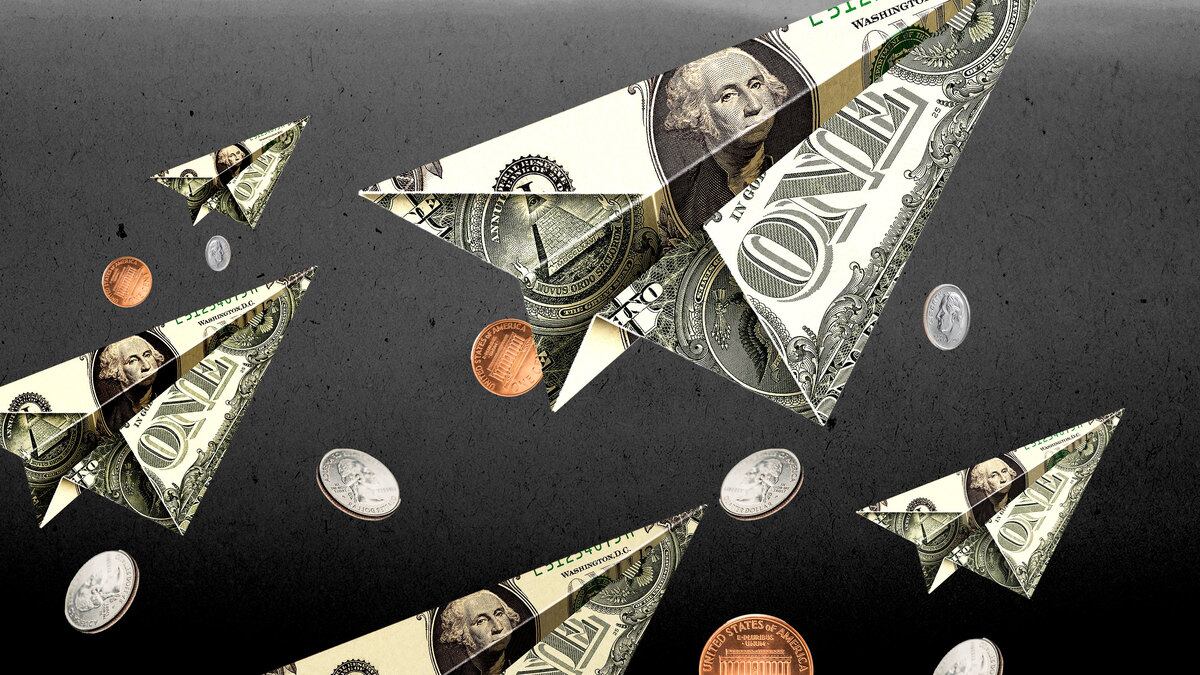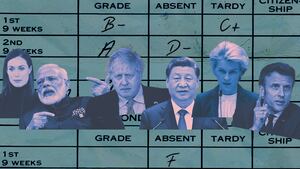A Second Cold War now seems inevitable. Just as inevitable appears to be a substantial surge in defense spending.
But is this really the right response?
The war in Ukraine has revealed that we significantly overestimated the threat posed by Russia. It’s also shown the effectiveness of cheaper, more nimble new technologies against more expensive traditional weapons systems—from tanks to manned aircraft to major navy vessels.
The Biden administration’s proposed defense budget of $813 billion is the largest such spending request since World War II. What is more, there is every sign that before the budget is approved, it is likely to grow larger. (And the above number does not include the aid packages being approved for Ukraine, the latest of which totals over $40 billion.) Already, senior Biden defense officials, such as Deputy Secretary of Defense Kathleen Hicks, have indicated a willingness to up the number to compensate for the additional costs associated with inflation. And there is pressure from both parties for additional increases.

Driving the spending is the sense that however the war in Ukraine progresses, tension between Russia and NATO will continue at a high level for the foreseeable future. In addition, there is a widespread perception in Washington that China poses an even greater threat.
Meanwhile, defense contractors are ramping up their push for additional funds for the big ticket programs that have made the U.S. defense budget by far the world’s largest, bigger than the next 11 biggest defense budgets in the world added up. As noted by Dan Froomkin of Responsible Statecraft, this is well illustrated by the recent appearance of the CEO of Lockheed Jim Taiclet on CBS’s Face the Nation when he made a direct pitch for selling more “products and systems like F-16, F-35, patriot missiles, THAAD missiles” as well as Javelin anti-tank missiles.
While some critics of the likely increases in spending come from domestic politicians who continue to be disturbed by the degree to which pumping money into our military takes it away from vital social programs, arms control experts are also worried we may not be learning the right lessons from the current conflict and past experience.

President Biden speaks about security and the conflict in Ukraine during a visit to the Lockheed Martins Pike County Operations facility in Alabama, which manufactures weapons systems.
Nicholas Kamm/AFP via GettyEmma Belcher, president of the Ploughshares Fund and formerly Director of Nuclear Challenges at the John D. And Catherine T. MacArthur Foundation, argues, “We need to be smarter about spending on what really keeps us safe, determining strategy and investing according to needs and not interests.” Belcher adds, “We need to resist the temptation to think that bigger and more is better,” noting that spending drastic budget increases will only lead Russia to do the same.
With regard to nuclear weapons in particular—an area where a costly major modernization is seen as a top priority in the Pentagon—Belcher says they’ve “done little for the U.S. and NATO in the Ukraine situation,” but they have been used as a “blackmail tool” by Putin.
“The answer is not to double down on nuclear weapons or kid ourselves that “smaller” nuclear weapons are not devastating and game-changing,” Belcher adds.
Jon Wolfsthal, NSC senior director for Arms Control and Nonproliferation during the Obama administration says, “If we do not objectively assess what we got wrong, as well as what we got right in Ukraine, then we are not going to be as efficient or successful as we could be.”
Wolfsthal says that, too often, the U.S. political and defense classes have succumbed to threat inflation. But, he argues, focusing only on worst case scenarios leads “to wasteful, unnecessary, and in some cases, counter-productive defense spending that has major implications for our country.”
He says it’s more than likely that the U.S. has also “inflated China’s defense capabilities over what they are”—which he called a “pacing threat” that will, too, “drive defense spending higher than it needs to be to address the military capabilities China possesses and is likely to possess.”
But, Wolfshal adds, even if our projections on China’s defense growth—including nuclear, space, and cyber—are pretty good, “it is not clear that the correct response is matching.” He says Ukraine has shown that “defensive technology can greatly counter offensive capability at a fraction of the price.”
Even some senior-level career military officers acknowledge the impulse toward threat inflation. Former Director of National Intelligence James Clapper told me that he has “dialed down a bit the magnitude of the military threat posed by China.” He also believes we should be open but careful about the apparent “lessons” Ukraine may be offering—with regards to the changing nature of warfare. Clapper says, for example, that the “the sinking of the Moskva doesn’t bode well for carriers. Is the era of the tank over? I wonder. We need a mix of high-end manned systems which can control supporting unmanned vehicles, whether air or maritime.”
However, there are notable voices of caution against assuming China’s military has the same kind of “rotten core” that afflicts Russia’s.
“The data suggests that China is accelerating its increase in military capability via technology and massive scale of production by using their vastly better resources,” warns former NATO Supreme Allied Commander James Stavridis.
He adds: “My bet is [China] would put up a better showing than the Russians, and remember the battlefield will be maritime, space, and technological—where qualities of pure leadership and heavy logistics are less of a factor than they are in the blood and the mud of Ukraine.”

Destroyed Russian military vehicles lie in a garbage dump in Bucha, on the outskirts of Kyiv, on May 10.
Aziz Karimov/SOPA Images/LightRocket via GettyThe Biden administration’s push for larger budgets is driven by the view that we need to be more nimble and recognize the limitations of some legacy systems; invest in new technologies, and at the same time, maintain and grow our capacity to project power over great distances. Senior officials on the administration’s national security team believe that while asymmetric capabilities are useful in the defense of “frontline partners” like Ukraine or Taiwan, the threats posed by our enemies require spending on things like lift capability, tankers, long-range aircraft (both manned and unmanned), precision weapons and both surface and undersea advanced maritime systems. Officials also emphasize modernizing the nuclear arsenal—while acknowledging the importance of investing in cyber, electronic warfare, and space, the latter of which is especially expensive.
Admiral Stavridis, speaking to the mix of what we need and where we need to update told me, “In terms of systems, the key strategic triad of the future is less about huge, expensive, legacy platforms and more about what delivers intelligence, smooth command control, pinpoint Lethality, long dwell surveillance, and logistics. This puts a premium on unmanned vehicles, special forces, cyber security, space systems, and—in particular if we are talking about China—maritime capability. Some of these are very expensive, others are very inexpensive. But it is too soon to say we no longer need any of the legacy systems.”
He goes on to add, “On nuclear weapons, I am concerned about the destabilizing effect of lighter, smaller, and less clear-cut systems—such as the sea launch cruise missile tipped with nuclear weapons. Trying to mix-and-match conventional cruise missiles with systems that have nuclear capability generates real uncertainty in the mind of an opponent, who might overreact and escalate to a nuclear scenario. That is a significant worry.”
Retired Army Gen. Wesley Clark, also a former NATO Supreme Allied Commander, warns that we must be careful about the idea of threat inflation, noting that, “There is no precision in this business of national security. If you underinvest and lose and war begins, all bets are off. At that point, what difference does saving that $100 billion really make?” Clark adds that while our spending is currently nominally at its highest levels, we are still below our Cold War spending levels as a percentage of GDP.
While Clark acknowledges the importance of intelligence, electronic warfare, air defense, and precision long range weapons, he also argues, “We still need armored systems. You’ll see that in Ukraine when the land dries out and the Russians try to make a breakthrough. A 50-mile push. That is possible in the next few weeks and would devastate Ukraine’s positions. And without armored forces with mobile artillery they would be encircled and destroyed.”
Clark concludes, “There is no cheap national security. Can’t be done. Invest to deter. Don’t try to catch up when the fighting starts. There is always fat and excess in a budget of hundreds of billions. But we have squeezed and squeezed. We have to pony up to be secure and safe.”
Kori Schake—a former official at the White House, Pentagon, and State Department who is a senior fellow and director of foreign and defense policy studies at the American Enterprise Institute—concurs and goes further, arguing that this is really the time for a major increase in defense spending as a percentage of GDP. She dismisses the idea of threat inflation with regard to the Russians saying, “The honest truth is that it’s very difficult to know how good an army is until you fight it. And the circumstances vary in ways that also make armies better or worse.”
She then goes on to add, “While I agree that faster innovation to smaller, unmanned platforms would be advantageous, we shouldn’t ignore that our dominance at the high-intensity, platform-centric middle of the conflict spectrum has advantageously driven our adversaries to its margins. They can’t expect to win the Battle of Midway against us, so they are developing new ways of war. It doesn’t mean we should abandon the old ways, just that we, too, need to innovate.”
President Dwight Eisenhower, who knew something about war fighting, was the first to warn of the “unwarranted influence—whether sought or unsought” of what he called America’s military-industrial complex. He also said “Only an alert and knowledgeable citizenry can compel the proper meshing of the huge industrial and military machinery of defense with our peaceful methods and goals so that security and liberty may prosper together.”
At a moment like this one—when passion and circumstance can too easily motivate us to act without carefully weighing the choices before us—doing what’s easy (or simply what we have become accustomed to doing) poses a different kind of risk than the ones that are currently dominating the headlines. Spending choices, as Eisenhower noted, have profound consequences.
“Every gun that is made, every warship launched, every rocket fired signifies, in the final sense, a theft from those who hunger and are not fed, those who are cold and are not clothed. This world in arms is not spending money alone. It is spending the sweat of its laborers, the genius of its scientists, the hopes of its children,” Eisenhower presciently warned.
And such choices also have profound military consequences, as the profligate waste and corruption of the Russian defense establishment illustrates.
We seem to be hurtling without thinking into a new orgy of spending, when questioning choices will again be equated with weakness. That’s the perfect time to stop and recognize that this is a moment for all of us to be, as Eisenhower admonished, alert and to make ourselves knowledgeable.
For as he well understood—wisdom and taking the time to make informed decisions are really our first line of defense.







